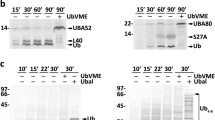Abstract
We have isolated and sequenced a 500-bp cDNAclone which is the murine homologue of a ubiquitin/60Sribosomal fusion protein. The cDNA and the deduced aminoacid sequence are highly conserved. Northernblotting demonstrates constitutive expressionin a mouse renal epithelial cell line and in mousekidneys. Upon stimulation with interferon-gamma orphorbol esters, the expression is not changed,contrastingwith the stimulation seen for polyubiquitin.Expression of the 16-kD ubiquitin/60S protein is alsodemonstrated in mouse epithelial cells.
Similar content being viewed by others
REFERENCES
Baker, R. T., and Board, P. G. (1991). The human ubiquitin-52 amino acid fusion protein gene shares several structural features with mammalian ribosomal protein genes. Nucleic Acids Res. 19:1035.
Benz, P. S., Fan, X. H., and Wüthrich, R. P. (1996). Enhanced tubular epithelial CD44 expression in MRL-lpr lupus nephritis. Kidney Int. 50:156.
Finch, J. S., St. John, T., Krieg, P., Bonham, K., Smith, H. T., Fried, V. A., and Bowden, G. T. (1992). Overexpression of three ubiquitin genes in mouse epidermal tumors is associated with enhanced cellular proliferation and stress. Cell Growth Different. 3:269.
Jennissen, H. P. (1995). Ubiquitin and the enigma of intracellular protein degradation. Eur. J. Biochem. 231:1.
Muller, S., and Schwartz, L. M. (1995). Ubiquitin in homeostasis, development and disease. Bioessays 17:677.
Nenoi, M. (1992). Induced accumulation of polyubiquitin gene transcripts in HeLa cells after UV-irradiation and TPA-treatment. Int. J. Radiat. Biol. 61:205.
Oertli, B., Beck-Schimmer, B., Fan, X., and Wüthrich, R. P. (1998). Mechanisms of hyaluronan-induced up-regulation of ICAM-1 and VCAM-1 expression by murine kidney tubular epithelial cells: Hyaluronan triggers cell adhesion molecule expression through a mechanism involving activation of nuclear factor-κB and activating protein-1. J. Immunol. 161:3431.
Redman, K. L., and Burris, G. W. (1996). The cDNA for the ubiquitin-52-amin o-acid fusion protein from rat encodes a previously unidentified 60S ribosomal subunit protein. Biochem. J. 315:315.
St. John, T., Gallatin, W. M., Siegelman, M., Smith, H. T., Fried, V. A., and Weissman, I. L. (1986). Expression cloning of a lymphocyte homing receptor cDNA: Ubiquitin is the reactive species. Science 231:845.
Rights and permissions
About this article
Cite this article
Sun, L., Wuthrich, R.P. Molecular Identification of a Murine Ubiquitin/60S Ribosomal Fusion Protein and Expression Study in Mouse Kidney. Biochem Genet 37, 139–147 (1999). https://doi.org/10.1023/A:1018778320235
Issue Date:
DOI: https://doi.org/10.1023/A:1018778320235




